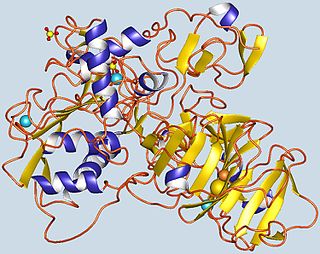Related Research Articles

Gelatinase A, also known as MMP2 is an enzyme. This enzyme catalyses the following chemical reaction

Leucyl aminopeptidases are enzymes that preferentially catalyze the hydrolysis of leucine residues at the N-terminus of peptides and proteins. Other N-terminal residues can also be cleaved, however. LAPs have been found across superkingdoms. Identified LAPs include human LAP, bovine lens LAP, porcine LAP, Escherichia coli LAP, and the solanaceous-specific acidic LAP (LAP-A) in tomato.

Xaa-Pro aminopeptidase 1 is an enzyme that in humans is encoded by the XPNPEP1 gene.

The PGPEP1 gene in humans encodes the enzyme Pyroglutamyl-peptidase I.

Dipeptidyl peptidase I is an enzyme. This enzyme catalyses the following chemical reaction

An Oligopeptidase is an enzyme that cleaves peptides but not proteins. This property is due to its structure: the active site of this enzyme is located at the end of a narrow cavity which can only be reached by peptides.
Pyroglutamate aminopeptidase is a type of enzyme that cleaves the peptide bond linking the N-terminal end of a polypeptide forming a cyclical lactam to the next amino acid residue. This cyclic structure protects the polypeptide from degradation but renders the protein difficult to analyze in the laboratory. Pyroglutamate aminopeptidase may be used to cleave the cyclical lactam and will therefore leave the next amino acid with a free N-terminal.
Prolyl aminopeptidase is an enzyme. This enzyme catalyses the following chemical reaction
Xaa-Pro aminopeptidase is an enzyme. This enzyme catalyses the following chemical reaction
Clostridial aminopeptidase is an enzyme. This enzyme catalyses the following chemical reaction
PepB aminopeptidase is an enzyme which catalyses the following chemical reaction:
Aminopeptidase S is an enzyme. This enzyme catalyses the following chemical reaction
Acylaminoacyl-peptidase is an enzyme. This enzyme catalyses the following chemical reaction
Xaa-Pro dipeptidyl-peptidase (EC 3.4.14.11, X-prolyl dipeptidyl aminopeptidase, PepX, X-prolyl dipeptidyl peptidase is an enzyme. It catalyses the following chemical reaction
Membrane Pro-Xaa carboxypeptidase is an enzyme. This enzyme catalyses the following chemical reaction
Pyroglutamyl-peptidase I (EC 3.4.19.3, also known as Pyrrolidonyl peptidase, is an enzyme found in bacteria, plants and animals.
Gamma-D-glutamyl-meso-diaminopimelate peptidase is an enzyme. This enzyme catalyses the following chemical reaction
Glutamyl endopeptidase II is an enzyme. This enzyme catalyses the following chemical reaction
Neurolysin is an enzyme. This enzyme catalyses the following chemical reaction
Thyrotropin releasing hormone degrading enzyme is a protein, specifically a pyroglutamyl-peptidase II enzyme, that in humans is encoded by the TRHDE gene.
References
- ↑ Bauer K, Nowak P (September 1979). "Characterization of a thyroliberin-degrading serum enzyme catalyzing the hydrolysis of thyroliberin at the pyroglutamyl-histidine bond". European Journal of Biochemistry. 99 (2): 239–46. doi: 10.1111/j.1432-1033.1979.tb13250.x . PMID 115687.
- ↑ O'Connor B, O'Cuinn G (July 1985). "Purification of and kinetic studies on a narrow specificity synaptosomal membrane pyroglutamate aminopeptidase from guinea-pig brain". European Journal of Biochemistry. 150 (1): 47–52. doi: 10.1111/j.1432-1033.1985.tb08986.x . PMID 2862039.
- ↑ Wilk, S.; Wilk, E.K. (1989). "Pyroglutamyl peptidase II, a thyrotropin releasing hormone degrading enzyme: purification and specificity studies of the rabbit brain enzyme". Neurochem. Int. 15: 81–89. doi:10.1016/0197-0186(89)90079-x.